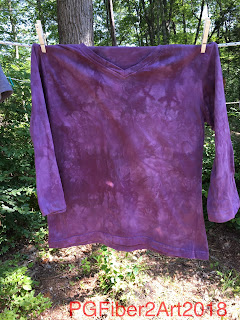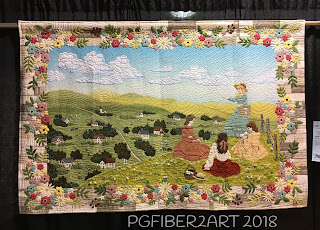Where did the time go? Didn't realize we'd missed so many days on the blog. Over the last 4 days, we've had studio time (more dyeing,etc.), went to the Keepsake Quilting warehouse sale, went to a Moose Festival in northern New Hampshire, and spent more time in the studio. Let's catch up.
We've been creating fabrics - first dyeing, then adding pattern and texture by printing with various methods as shown in the previous post. Here are some more of the completed fabrics.
Elizabeth has spent time at the embroidery machine to stitch out these outline images that will be colored in with Inktense pencils.
On Thursday we went to the Keepsake Quilting warehouse sale. The warehouse is about a mile up the road from the shop. We couldn't get into the parking lot at the warehouse, so we went on to the shop where there was a shuttle van taking people back and forth to the sale. We waited about 30 minutes for our ride. Fabric was priced at $5 a pound (about 3 yards). Yardage was laid out on tables in one of the tents; you had to buy the whole piece, no cutting. There were also boxes and boxes containing smaller pieces and scraps. Two other tents contained kits, patterns, packaged backings, wool pieces, you name it. These appeared to be leftovers from the catalog. Above you can see the line for the shuttle to go back to the store. It was shorter by the time we got in it, only about 15 minutes.
On Friday we drove about 3 hours north to Colebrook, NH, for the Moose Festival. Elizabeth's husband Bob wanted to go, and we were game to try something new. The fact that it included a quilt show was a plus. Other than that, it was a bit underwhelming.
The highlight for Bob was finding the micro brewery in town (emphasis on "micro") and having some Poutine (French fries topped with cheese curd and gravy).
Sue and Elizabeth checked out the quilt show in a local church. The show was only on Friday for 4 hours, and quilts were draped over the pews of the church.
We found our way by following the sign on the truck.
Rocks seem to be the thing this summer. We also saw some in Gloucester, VA a few weeks ago.
The Moose Fest had some craft and food vendors. The picture on the bottom left shows the sheaf toss. We saw the gentleman in the photo demonstrate; he picked up the "sheaf" with his pitch fork and tossed it over the bar attached to the ladder. The ladder can be raised and lowered to move the bar. We only saw the demo because the competition wasn't till later in the day. Other aspects of the festival included a classic car show, helicopter rides, a moose calling contest, and cow plop bingo. Elizabeth bought a bingo square; we'll let you know if she wins. Oh, by the way, we didn't see any moose - only the two-legged variety.

We left Colebrook and headed east across Dixville Notch, just to say we'd been there. This is the place that is first to vote in US presidential elections. In the 2010 census, there was a population of 12. There is a lovely lakeside Balsam Resort, but not much else (lots of green trees). We stopped in the town of Errols at the L.L. Cote store - if you need it, they have it and if they don't have it, you don't need it. Everything from hardware to clothing to shoes and boots to guns to convenience store food and ice cream. You have to go pretty far to find the next store, so get it while you can! From there we headed back south passing through the 13 Mile Woods (there was an actual sign); though that wasn't the end of the woods - that's mostly all there is up here! On past Mt. Washington and through Conway and back to Melvin Village. A long day.
Saturday was back to studio time. More on that in the next post.























































